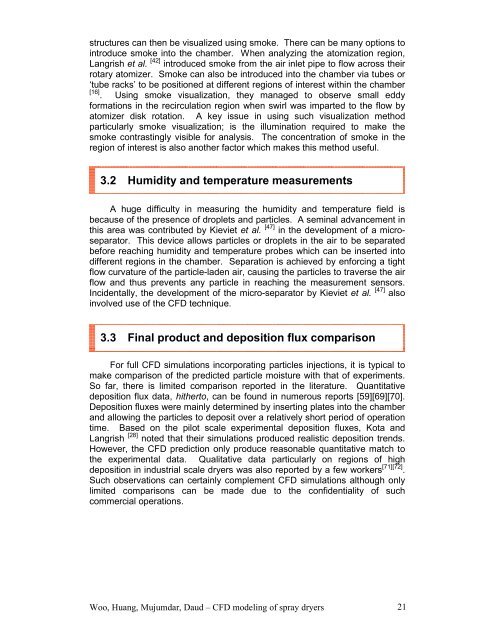Spray Drying Technology.pdf - National University of Singapore
Spray Drying Technology.pdf - National University of Singapore
Spray Drying Technology.pdf - National University of Singapore
Create successful ePaper yourself
Turn your PDF publications into a flip-book with our unique Google optimized e-Paper software.
structures can then be visualized using smoke. There can be many options to<br />
introduce smoke into the chamber. When analyzing the atomization region,<br />
Langrish et al. [42] introduced smoke from the air inlet pipe to flow across their<br />
rotary atomizer. Smoke can also be introduced into the chamber via tubes or<br />
‘tube racks’ to be positioned at different regions <strong>of</strong> interest within the chamber<br />
[16] . Using smoke visualization, they managed to observe small eddy<br />
formations in the recirculation region when swirl was imparted to the flow by<br />
atomizer disk rotation. A key issue in using such visualization method<br />
particularly smoke visualization; is the illumination required to make the<br />
smoke contrastingly visible for analysis. The concentration <strong>of</strong> smoke in the<br />
region <strong>of</strong> interest is also another factor which makes this method useful.<br />
3.2 Humidity and temperature measurements<br />
A huge difficulty in measuring the humidity and temperature field is<br />
because <strong>of</strong> the presence <strong>of</strong> droplets and particles. A seminal advancement in<br />
this area was contributed by Kieviet et al. [47] in the development <strong>of</strong> a microseparator.<br />
This device allows particles or droplets in the air to be separated<br />
before reaching humidity and temperature probes which can be inserted into<br />
different regions in the chamber. Separation is achieved by enforcing a tight<br />
flow curvature <strong>of</strong> the particle-laden air, causing the particles to traverse the air<br />
flow and thus prevents any particle in reaching the measurement sensors.<br />
Incidentally, the development <strong>of</strong> the micro-separator by Kieviet et al. [47] also<br />
involved use <strong>of</strong> the CFD technique.<br />
3.3 Final product and deposition flux comparison<br />
For full CFD simulations incorporating particles injections, it is typical to<br />
make comparison <strong>of</strong> the predicted particle moisture with that <strong>of</strong> experiments.<br />
So far, there is limited comparison reported in the literature. Quantitative<br />
deposition flux data, hitherto, can be found in numerous reports [59][69][70].<br />
Deposition fluxes were mainly determined by inserting plates into the chamber<br />
and allowing the particles to deposit over a relatively short period <strong>of</strong> operation<br />
time. Based on the pilot scale experimental deposition fluxes, Kota and<br />
Langrish [28] noted that their simulations produced realistic deposition trends.<br />
However, the CFD prediction only produce reasonable quantitative match to<br />
the experimental data. Qualitative data particularly on regions <strong>of</strong> high<br />
deposition in industrial scale dryers was also reported by a few workers [71][72] .<br />
Such observations can certainly complement CFD simulations although only<br />
limited comparisons can be made due to the confidentiality <strong>of</strong> such<br />
commercial operations.<br />
Woo, Huang, Mujumdar, Daud – CFD modeling <strong>of</strong> spray dryers 21

















